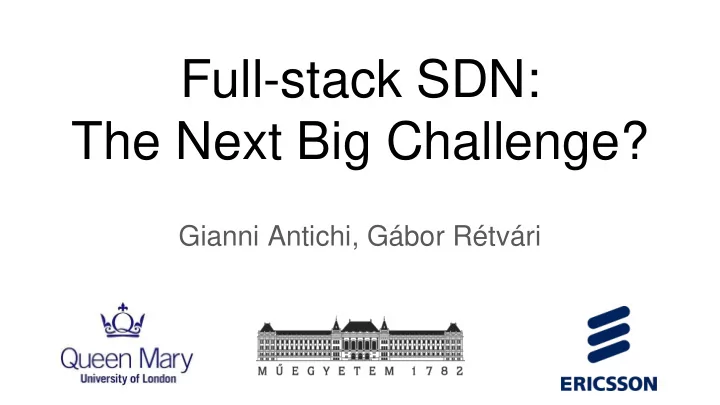

Full-stack SDN: The Next Big Challenge? Gianni Antichi, Gábor Rétvári
Disclaimer ● This is a "Challenge" paper ● Don’t expect answers, only some (hopefully) interesting questions
TLDR; Ethernet bridges handle packets at L2, IP routers at L3, and middleboxes add L4 processing capability Switch Application Transport Network Link
TLDR; Ethernet bridges handle packets at L2, IP routers at L3, and middleboxes add L4 processing capability Switch SDN Controller Software Defined Networking (SDN): Application impose L2-L4 network policies Transport centrally Network Link
TLDR; Ethernet bridges handle packets at L2, IP routers at L3, and middleboxes add L4 processing capability Switch SDN Controller Software Defined Networking (SDN): Application impose L2-L4 network policies Transport centrally Network We argue it is time to extend SDN Link up into the Application layer (L7)
TLDR; Questions? :D
Cloud 1.0: Monolithic apps deployed into VMs Full app instances Server Server Virtual Virtual deployed into VMs Machine Machine Ethernet, IP Exchange traffic over Virtual Virtual L2 and L3 protocols Machine Machine Virtual Virtual Switch Switch Fabric
Cloud 2.0: Microservices Micro- Micro- Server Server Fine-grained decompo- service service HTTP, gRPC SOAP, sition of business logic Container Container WebSocket.. Micro- Micro- into loosely coupled service service microservices Container Container Virtual Virtual Lightweight isolation in Machine Machine Linux containers Virtual Virtual Machine Machine Expose/consume services over Virtual Virtual application-layer (L7) Switch Switch protocols Fabric
Takeaway 1 With the transition to the microservice architecture, the main network communication pattern becomes application-layer (L7) protocols
Looking glass on microservices Microservice communication relies on Micro- critical L7 network functions that are service App logic hardcoded into applications Container L7 Network stack L4 Examples: Load-balancing, L7 ACLs, L3 circuit breaking, L7 health-checking, L2 encryption, policing, observability, RDMA authentication and authorization Virtual Virtual Port Port Cannot impose L7 network policies Virtual centrally Switch
Example 1: Filter HTTP REST API calls Microservices typically expose/consume Micro- Micro- services over RESTful HTTP APIs service service query read-only These look the same for a conventional HTTP GET L2-L4 SDN switch (TCP, port=80/443) The network SHOULD be able to filter connections based on HTTP header Virtual network HTTP POST fields The control plane SHOULD be able to set L7-ACLs in switches
Example 2: Differentiate/route based on VXLAN ID If a new service version is deployed Micro- Micro- alongside production code.. service service production VXLAN tunnels look the same for an L2- VXLAN Network L4 SDN switch (UDP port is 4789) Normal Identifier? traffic The network SHOULD be able to handle Test traffic at the granularity of VXLAN traffic Virtual network Network Identifier! The control plane SHOULD be able to Micro- service install VXLAN routing rules in the test dataplane
Example 3: Police RTP streams by user ID RTP streams look the same for Micro- Micro- Micro- Micro- service service service service an L2-L4 SDN switch The network SHOULD be able to User 1: 10 Kbps rate-limit RTP streams based on User 2: 100 Kbps user ID (SSRC) Virtual network The control plane SHOULD be able to set/query counters at the granularity of individual RTP streams
Takeaway 2 Application-layer network functions SHOULD be moved out from applications into the dataplane to allow the enforcement of L7 network policies centrally
State-of-the-art: The service mesh Microservice Application The service mesh is an L7- Container SDN to manage HTTP-based Business Logic microservice communication Service Proxy Istio L4-L7 policies Achieved by injecting an HTTP Virtual service proxy to each Port microservice Virtual Switch Kubernetes L2-L3 policies
State-of-the-art: The sidecar proxy model Microservice Microservice Application Application Container Container Business Logic Business Logic Service Proxy Service Proxy L4-L7 policies L4-L7 policies Virtual Switch L2-L3 policies The proxy runs side-by-side with the app and intercepts all ingress/egress traffic
State-of-the-art: The sidecar proxy model Microservice Microservice Application Application Container Container Business Logic Business Logic Service Proxy Service Proxy L4-L7 policies L4-L7 policies Virtual Switch L2-L3 policies Even a local packet exchange requires stitching 3 connections one after the other This is 6 kernel-space--user-space context switches (remote calls are even worse)
State-of-the-art: The sidecar proxy model Microservice Microservice Application Application Container Container Business Logic Business Logic Service Proxy Service Proxy L4-L7 policies L4-L7 policies Virtual Switch L2-L3 policies Check the paper for some numbers on how this architecture might affect network function performance!
Takeaway 3 The state-of-the-art L7 SDN is restricted to HTTP and runs on top of the inefficient sidecar-proxy model
The challenge: Full-stack SDN Microservice Microservice Application Application Container Container Business Logic Business Logic Service Proxy Service Proxy L4-L7 policies L4-L7 policies Virtual Switch L2-L3 policies
The challenge: Full-stack SDN Microservice Microservice Application Application Container Container Business Logic Business Logic Full-Stack Virtual Switch L2-L7 policies A local packet exchange would require now only 1 simple connection This is only 2 kernel-space--user-space context switches!!!!
Full-stack SDN: How? Process traffic at any layer in the protocol stack (UDP, TCP, RTP, WebSocket, Ethernet, IP, etc..) Key components: ○ Full-stack SDN switch ○ Full-stack SDN control plane See a couple of initial ideas in the paper
Conclusions Takeaway 1 With the transition to the microservice architecture, the main network communication pattern becomes application-layer (L7) protocols Takeaway 2 Application-layer network functions SHOULD be moved out from applications into the dataplane to allow the enforcement of L7 network policies centrally Takeaway 3 The state-of-the-art L7 SDN is restricted to HTTP and runs on top of the inefficient sidecar-proxy model Challenge: Full-stack SDN
Thanks!
Recommend
More recommend